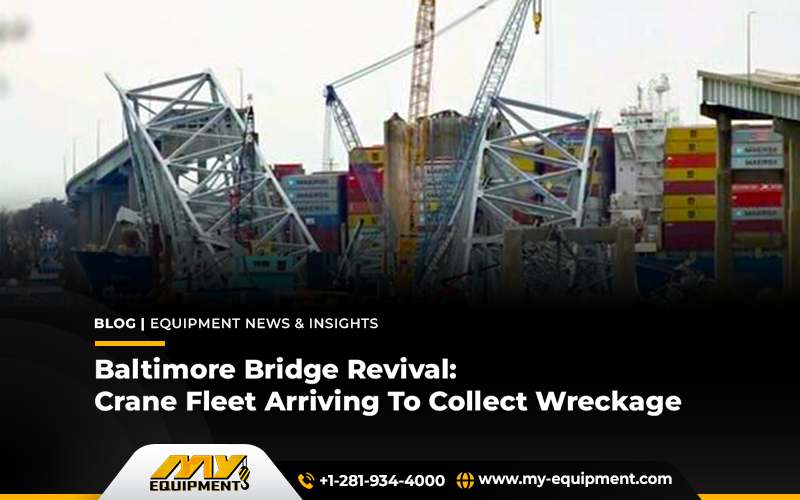Earlier in the last week, a massive catastrophe event was reported which has left everyone in shock and grief. When a Cargo ship DALI collided with the major Francis Scott Key Bridge in Baltimore, resulting in the blockade of traffic, the loss of people, and an interruption in the supply almost nationwide.
Luckily, the incident got sudden attention and the process of revival and reconstruction was forced to begin in an emergency. The arrival of the crane fleets and the recovery of missing bodies are being done parallelly to reduce the damage as much as possible.
Amid this catastrophe, sudden action has been taken and the first heavy lift crane already arrived at the spot to collect and reconcile the bridge wreckage. The other equipment and the fleet of cranes are in line to reach the location as the recovery process further moves. The U.S. Coast Guard has recently released a photo that the steel beams started to be cut off in response to the quick recovery.
What quick measures were taken?
Following the collapse, the Biden Administration promptly granted Governor Wes Moore’s request for emergency funding. The mobilization, operations, and debris recovery phases will get this crucial $60 million in funds for emergency relief, indicating an intensive effort to confront the situation head-on.
It was seen and reported that the massive lift cranes including a 400-ton revolving crane barge and a 1000-ton derrick barge have arrived. The 100-ton crane for sale could also be used but might be in the hold for the later removal of upper floating debris. These massive cranes are obliged to lift tons of debris from the river and the remains of the bridge structure. All the skilled and experienced personnel have been called for the reconciliation process to speed up the recovery. As long as the recovery takes time, the entire economy in the state will be in the shunt. Hence, the state is all set to take quick measures despite the means to be used.
What cost human has paid off this incident?
Everyone is in grief and in a state of shock as the recovery of the lost human lives can never be compensated at any cost. Although the organization are taking every step to approach the victims’ families and giving them all kinds of aid, they need the pain can never be taken off of them.
The report says that at the moment of the collapse, eight people were on the bridge as members of a construction crew. Two have been rescued, two have had their bodies found, and four are still unaccounted for and believed to be dead.
Moreover, the collapse of the bridge has an economic impact not just on the region but also outside of it. The ninth-busiest port in the US, the Port of Baltimore, is still blocked to vessel travel, which prevents essential import and export operations. The urgent necessity to reopen the port and bring economic stability to the area is underscored by the thousands of jobs directly and indirectly related to port activities at risk.
Obstacles during the rehabilitation of the bridge
Challenges remain as the cleanup and recovery operations proceed. Meticulous planning and execution are necessary for the complex tasks of breaking up waste into smaller pieces, cleaning the channel, and guaranteeing the safety of marine traffic. There is still no set schedule for the Port of Baltimore to reopen, despite officials’ best efforts to move as quickly as possible without sacrificing security.
There is optimism for a thorough and quick recovery with the aid of federal backing, which includes the first $60 million in emergency money and President Biden’s initiative to pay for the whole cost of rebuilding the bridge. Considering the urgent need for assistance after this tragedy, Maryland lawmakers are also crafting emergency legislation to replace affected workers’ income.
Consistency and resilience amid difficulties
As Baltimore navigates this challenging time in its history, a strong spirit is apparent. With the help of federal, state, and local agencies, the dedication of rescue workers and cleanup crews, and the outpouring of support from both local and distant populations, challenges can be overcome with resilience and unity.
Even though there may be a long and difficult road ahead until full recovery, the determination to rebuild and restore is steadfast. The tragic Francis Scott Key Bridge collapse serves as a stark reminder of how easily infrastructure can fail and how crucial it is to take preventative action to guarantee resilience and safety in the face of unanticipated circumstances.
Wrap Up
The cleanup and recovery operations after the collapse of Baltimore’s Francis Scott Key Bridge highlight the relationship between the economy, infrastructure, and human life. Lessons learnt and unity created pave the path for a better and more resilient future as the city and its partners work relentlessly to restore regularity and handle the impact of this tragedy.


 1400 Broadfield Blvd, Houston, TX 77084,
USA.
1400 Broadfield Blvd, Houston, TX 77084,
USA. omer@my-equipment.com
omer@my-equipment.com